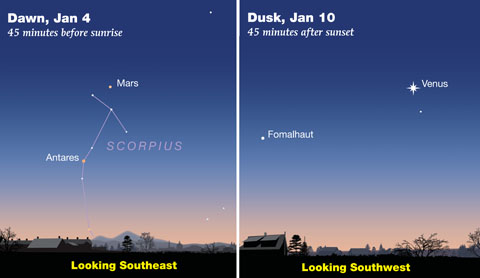New Year's resolution: Do more stargazing! (Hint: Get an easy and entertaining head start by downloading this month's Sky Tour podcast for a guided tour of the night sky.)
LISTEN HERE:
Podcast: Play in new window | Download
Subscribe: Apple Podcasts | Google Podcasts | Spotify | Email | RSS | More
Podcast: Play in new window | Download
Subscribe: Apple Podcasts | Google Podcasts | Spotify | Email | RSS | More
For a fascinating naked-eye tour of the major sky sights in January evening skies, play or download this month's Sky Tour episode.
Start your stargazing year off right in the first week of January, with the arrival of the Quadrantid meteor shower. These meteors get their name from Quadrans Muralis, an obsolete constellation near the handle of the Big Dipper. Fortunately, this year the "Quads" have a peak that's well timed for North America in the wee hours of January 4th.

Sky & Telescope
Early risers can easily spot Mars in the predawn sky. It rises about 3 hours before the Sun, positioned well up in the southeast 45 minutes before sunrise. Around mid-January, Mars glides near a bright, easy-to-spot star. Which one? Download this month's Sky Tour to find out!.
Meanwhile, Venus, is putting on a show in the southwestern sky after sunset. It starts the month about 25° up at sunset but climbs quite a bit higher by month’s end. Get used to seeing Venus after sundown, because it’ll be with us in the evening sky until May.
This time of year, the northern sky is ablaze with bright stars and easy-to-spot constellations. Our Sky Tour describes two of them — one a famous celestial queen and the other a well-known hunter.
For many of us, this time of year brings cold nights — despite the fact that Earth is closer to the Sun than average (by about 2%). But it's also a time when crystal-clear skies often beckon you. Why not head outside and let our monthly Sky Tour podcast guide you to some of the best sights in the nighttime sky?
 2
2

Comments
caballerodiez
January 1, 2020 at 5:47 pm
Great post.
Btw, for those interested in super habitable planets, this video might interest you: youtu.be/7UJEPKLmznk
You must be logged in to post a comment.
Pencil BFB
January 12, 2020 at 6:51 am
Sorry, can't stargaze from Metro Manila for now.
The Taal Volcano erupted 12 January and there are black clouds around, except where facing the nautical twilight. I saw thunder coming from the south. I was able to spot Sirius, but not as clear as before. Let's hope for the best, that Taal will weaken its activity. This is also for us Manileño stargazers and astronomers.
You must be logged in to post a comment.
You must be logged in to post a comment.